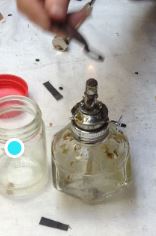-
Lohff & Pfeiffer
About Lohff & Pfeiffer
Iimprint
Contact
Newsletter
Location
L&P team
- Instruments
General
Trade options
About clarinet
Search specific instrument
Ab-clarinet
Eb-clarinet
D-clarinet
C-clarinet
Bb-clarinet
A-clarinet
Mozart basset-clarinet A
G-clarinet
Bassethorn F
Alto-clarinet Eb
Bass-clarinet
Contraalto Eb-clarinet
Contrabasse Bb-clarinet
German-Albert system Bb
Reform Boehm A & Bb
Peter Bastian Instruments
Plateau clarinets
Quartertone clarinet
- L&P Optimization
Optimization
Customization
Specialities
Special Keywork
- Accessories
General
Care products
For instruments
Reeds
Tools for reeds
Straps and hand rests
- Repair
Book time
About Repair
Maintenance
Plating-Surface treatment
Pads
Padding style
Cracks
Tone hole problems
Joints
- Tips & Advice
How to..
Videos
Worldwide external information
Problems & help
Education & learning

.Padding
Requirements
The right padding technique is crucial for the quality of woodwind instruments. Only a really well-padded instrument is dense enough to show the full potential of the instrument.
Very precise mechanics and flawless tone holes are the first prerequisite for this. Key play in the mechanics makes good padding impossible. A key may only move around its own axis. However, if you can push them to the right or left, or if you can wiggle them back and forth, solid airtight padding is impossible. Any attempt to do so is a waste of time and money.
During a general overhaul, we spend about 80% of the time creating the conditions for good padding. Without this preparatory work, it is impossible to guarantee good work.
Definition
Pads are an essential part of woodwind instruments. The type and style of the pad, as well as the technique used, have an important impact on the way the instrument plays. In order to meet the different requirements and tastes, we offer a wide selection of different Upholstery types
The Challenge
The air you blow into a woodwind is like gasoline for your car. It gets it going. Every little leak reduces efficiency, productivity, sound and response. Uncontrolled air causes all sorts of problems, including intonation problems and lack of projection. If the instrument is to play optimally, the seal between the cushion and the tone hole must be as airtight as possible. An efficient mechanism is crucial for adequate padding. Large instruments have 24 sound holes which you have to close with just 10 fingers. To do this without pressing hard is a real challenge, and requires high quality in material and workmanship. If the keys have even a little play, they can move back and forth, not sealing the tone hole properly, making a tight seal impossible.
Another problem is damaged tone holes, cracks or leaky wood-metal connections, as they often occur on thumb or register holes.
The padding Influence
Pads are not only responsible for the seal, but are also an essential part of the sound and resonance of the instrument. Switching to a different type of pads changes the character and sound of the instrument enormously.
Reliability and Lifespan
After all, the pads are the most important parts that determine how long your instrument will work properly. It can range from 1-20 years !!!
Pad quality
Good padding requires that the pads are absolutely even, without deep impressions, and that the weight of the keycover alone can properly close the hole. The allowed tolerance is about 1/100 millimeter. The pad must close securely without additional effort.
Pad Quality
To get these results, only the best pads should be installed, and they are not cheap. They may look primitive, but it's an art to make and work with them. We have to work with a tolerance of 1/100 mm to get it right. That corresponds to only a quarter of the thickness of hair!
The padding technique
We differentiate between different padding techniques. It has a big impact on the quality and lifespan of work:
1. Pad pending
2. Press padding or cushioning
3. Pad Shimming
4. Cork grinding
In addition to these techniques, we find that some people bend the pad cups to save time, which is very common with saxophones and student flutes. They do more harm than good and you should stay away from it unless the key is bent due to an accident or poor workmanship
Help us to get better
Was this article helpful?
Comments, additions or questions are always welcome at: info@clarinet.dk(C) 2014 - by Lohff & Pfeiffer - Brøndbyvej 211 - 2625 Vallensbæk + 45 3535 8643 - SE DK 1895 7485 info@clarinet.dk - Instruments






